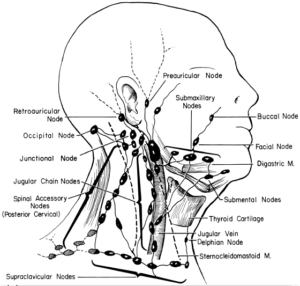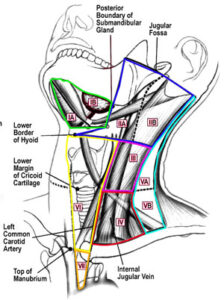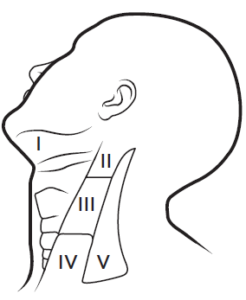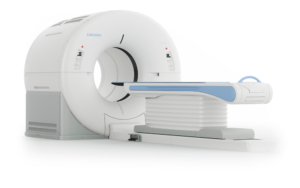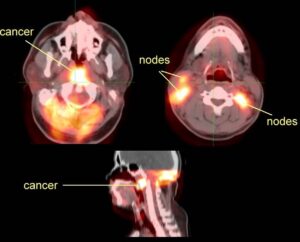General Information About Nasopharyngeal Cancer
- Nasopharyngeal cancer arises form in the tissues of the nasopharynx.
- Risk factors include ethnic background and exposure to Epstein Barr virus.
- Signs of nasopharyngeal cancer include nasal bleeds, and difficulties in breathing, speaking, or hearing.
Nasopharyngeal cancer arises from the tissues of the nasopharynx.
The nasopharynx is the upper part of the pharynx (throat) behind the nose. The nostrils lead into the nasopharynx. An opening on each side of the nasopharynx leads into the ear (Eustachian tube). Nasopharyngeal cancer most commonly starts in the squamous cells that line the nasopharynx.
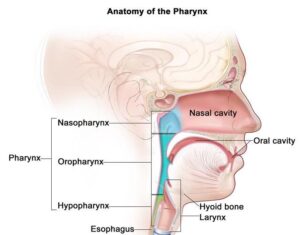
Risk factors include ethnic background and exposure to the Epstein-Barr virus
Risk factors for nasopharyngeal cancer include the following:
- Chinese or Asian ancestry.
- Epstein-Barr virus: The Epstein-Barr virus has been associated with certain cancers, including nasopharyngeal cancer and somelymphomas.
- Alcohol excess
Signs of nasopharyngeal cancer include nasal bleeds and difficulties in breathing, speaking, or hearing
These and other signs and symptoms may be caused by nasopharyngeal cancer or by other conditions. Check with your doctor if you have any of the following:
- A lump in the nose or neck.
- Trouble breathing or speaking.
- Trouble hearing.
- Pain or ringing in the ear.
- Change to your voice (sounded like having a “hot potato in your mouth)
Examination, diagnosis, investigations
- Clinical examination and history: Your OMFS H&N surgeon will ask about your social habits (smoking and drinking) and take a thorough medical history, including asking you about your ethnic background. The neck will be felt for swollen lymph nodes. A thorough neurological examination will be performed, as many nerves that travel to your body from your brain are in close proximity to the nasopharynx
- Fiberoptic nasoendoscopy: If needed, your OMFS H&N surgeon will pass a thin tube-like camera through your nose, to examine the back of your nose and the nasopharynx.
- Biopsy: This is paramount in order to diagnose cancer. Your OMFS H&N Surgeon will take a sample of the abnormal area. Given the difficulty in getting to this particular area of the throat, you may need to have an EUA (Examination Under Anaesthesia)
- Fine Needle Aspiration: This is a form of biopsy, but instead of tissue sample, the OMFS H&N Surgeon samples few cells with the help of a syringe and needle. This is usually the case for lumps in the neck (lymph nodes). The cells are viewed under a microscope to find out if they are abnormal.
- MRI (Magnetic Resonance Imaging): A procedure that uses a magnet, radio waves, and a computer to make a series of detailed pictures of areas inside the body. An MRI of your H&N region is required to stage the cancer
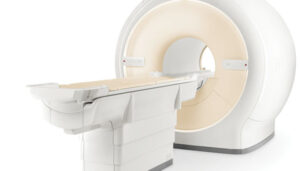
- CT scan F5: A computerised x-ray that makes a series of detailed pictures of areas inside the body, taken from different angles. A CT scan of your thorax (chest) is needed for staging H&N cancer, to exclude disease spread and/or second primaries in the lung
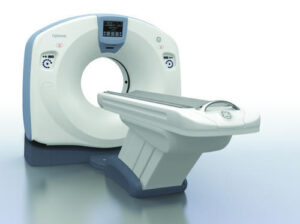
CT scanner - PET scan (positron emission tomography scan: A procedure to find malignant tumour cells in the body. A small amount of radioactive glucose (sugar) is injected into a vein. The PET scanner takes picture of where glucose is being used in the body. Malignant tumour cells show up brighter in the picture because they are more active and take up more glucose than normal cells do. The PET scan is particularly useful when the cancer present as an isolated neck lump and the primary tumour is very small (usually hidden in the base of the tongue or the tonsils).
- EUA (Examination Under Anaesthesia): For this exam, you will be asleep. Your OMFS H&N surgeon will thoroughly examine the areas of your throat and take samples from abnormal looking areas
- Epstein-Barr virus (EBV) test: A blood test to check for antibodies to the Epstein-Barr virus. These are found in the blood of patients who have been infected with EBV.
Factors affecting the outcome
The prognosis (chance of cure and recovery) depends on:
- The general fitness of the patient
- Whether the patient is/was a smoker.
- The stageof the cancer.
Stages of nasopharyngeal Cancer
- Nasopharyngeal cancer is staged differently than the rest of the H&N cancers
- There are three ways that cancer spreads in the body.
- Cancer may spread from where it began to other parts of the body.
- The following stages are used for nasopharyngeal cancer:
- Stage 0 (Carcinoma in Situ)
- Stage I
- Stage II
- Stage III
- Stage IV
The way nasopharyngeal cancer is staged is complex – your OMFS H&N surgeon will explain the stage and the implications once all tests are completed
The process used to find out if nasopharyngeal cancer has spread to other parts of the body is called staging. Staging guides decision-making and treatment.
There are three main ways that cancer spreads in the body.
Cancer can spread through tissue, the lymph system, and the blood:
- The cancer spreads from where it began by growing into nearby areas.
- Lymph system. The cancer spreads to the lymph glands (in H&N cancer it spreads in the neck lymph glands).
- The cancer spreads from where it began by getting into the blood. The cancer travels through theblood vessels to other parts of the body (distant metastasis).
When cancer spreads to another part of the body, it is called metastasis
Treatment
- The nasopharynx is an area that is very difficult to access, therefore open surgery has limited indications
- Surgery is reserved for cases that do not respond to radiotherapy
- Patients with nasopharyngeal cancer should have their treatment planned and delivered by a team who is expert in treating head and neck cancer.
- Two types of standard treatment are used:
- Radiation therapy
- Chemotherapy(only in selected cases and as adjunct to radiotherapy)
- Treatment for nasopharyngeal cancer is difficult, complex and may cause side effects.
- Follow-up tests may be needed.
Patients with nasopharyngeal cancer should have their treatment planned by a team of doctors who are expert in treating head and neck cancer.
Your expert OMFS/H&N Surgeon, who will guide the team for you, will oversee your treatment. A team approach is required to overcome the potential side effects of the treatment. The team usually include:
- Head and necksurgeon
- Radiation oncologist
- Speech therapist
- Dietitian
- Pathologist
- Radiologist
- CNS
Radiatiotherapy
Radiatiotherapy is a cancer treatment that uses high-energy radiation to kill cancer cells or keep them from growing. For nasopharyngeal cancers, it can be used alone or in a combination with chemotherapy as the single required first line treatment. A specific type of radiotherapy, called IMRT (Intensity modulated radiation therapy) is preferred, as it reduces the side effects of the treatment
Surgery
Surgery for nasopharyngeal cancer is reserved for cases that do not respond to radiotherapy (salvage surgery). This is usually in the form of a neck dissection, which is the removal of the lymph glands from the neck (that nasopharyngeal cancer has spread into)
Side Effects
Treatment for mouth cancer is difficult and can result in life-changing side effects. Your OMFS H&N surgeon will follow you up and try to deal with these side effects whenever possible
- Xerostomia – dry mouth
- Difficulties in speech
- Difficulties in swallowing (may require feeding tube)
- Changes in appearance
- Weight loss
- Infection
- Lymphedema
- Chronic pain
- Osteoradionecrosis (ORN)
- Shoulder dysfunction
- Taste changes
- Loss of smell
- Scarring

